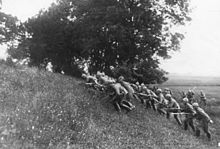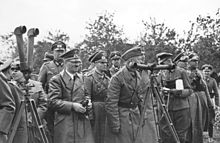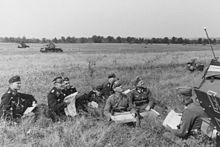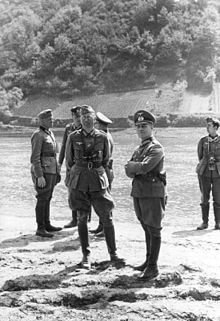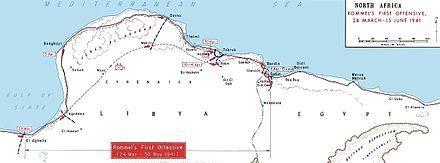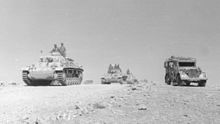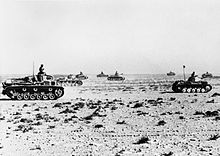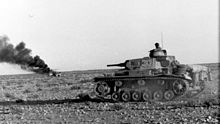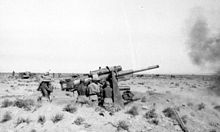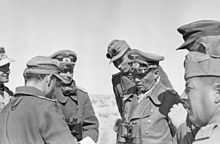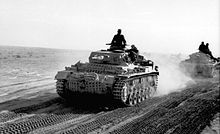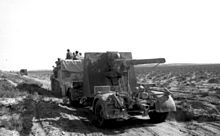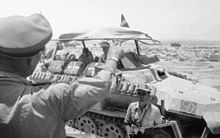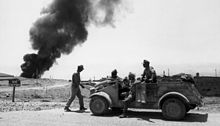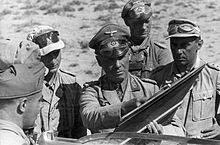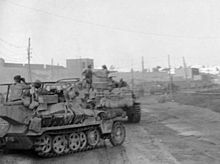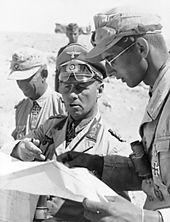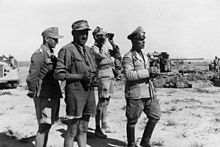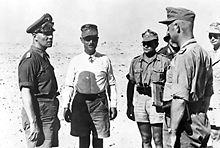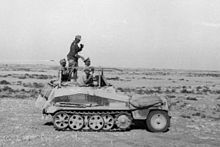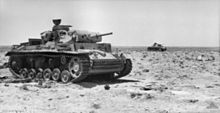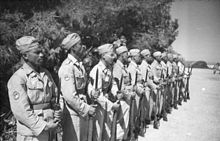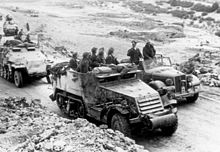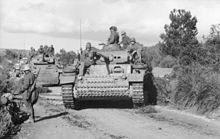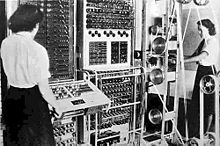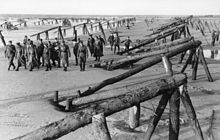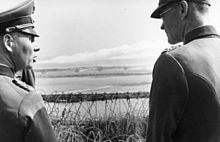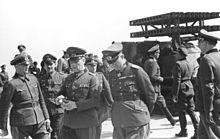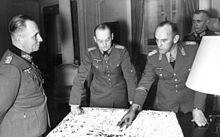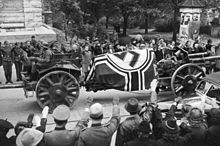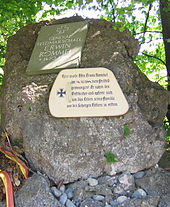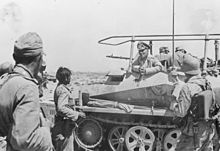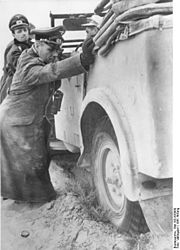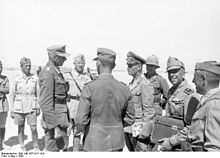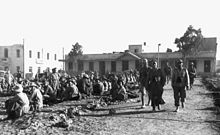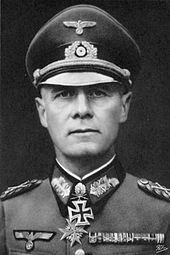
Erwin Rommel
Did you know...
This wikipedia selection has been chosen by volunteers helping SOS Children from Wikipedia for this Wikipedia Selection for schools. All children available for child sponsorship from SOS Children are looked after in a family home by the charity. Read more...
| Erwin Johannes Eugen Rommel | |
|---|---|
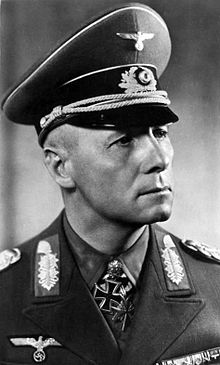 Generalfeldmarschall Erwin Rommel |
|
| Nickname | Wüstenfuchs (Desert Fox) |
| Born | 15 November 1891 Heidenheim, Kingdom of Württemberg, German Empire |
| Died | 14 October 1944 (aged 52) Herrlingen, Nazi Germany |
| Buried at | Cemetery of Herrlingen |
| Allegiance |
|
| Service/branch | |
| Years of service | 1911–1944 |
| Rank | Generalfeldmarschall |
| Commands held |
|
| Battles/wars |
|
| Awards |
|
| Relations | Manfred Rommel |
| Signature | |
Erwin Johannes Eugen Rommel (15 November 1891 – 14 October 1944), popularly known as The Desert Fox (Wüstenfuchs, listen), was a German Field Marshal of World War II. He won the respect of both his own troops and the enemies he fought.
Rommel was a highly decorated officer in World War I and was awarded the Pour le Mérite for his exploits on the Italian front. In World War II, he further distinguished himself as the commander of the 7th Panzer Division during the 1940 invasion of France. His leadership of German and Italian forces in the North African campaign established him as one of the most able commanders of the war, and earned him the appellation of the Desert Fox. He is regarded as one of the most skilled commanders of desert warfare in the conflict. He later commanded the German forces opposing the Allied cross-channel invasion in Normandy. His assignments never took him to the Eastern Front.
Rommel is regarded as having been a humane and professional officer. His Afrika Korps was never accused of war crimes, and soldiers captured during his Africa campaign were reported to have been treated humanely. Orders to kill Jewish soldiers, civilians and captured commandos were ignored. Late in the war, Rommel was linked to the conspiracy to assassinate Adolf Hitler. Since Rommel was a national hero, Hitler desired to eliminate him quietly. He forced Rommel to commit suicide with a cyanide pill, in return for assurances that Rommel's family would not be persecuted following his death.
Early life and career
Rommel was born on 15 November 1891 in Heidenheim, 45 kilometres (28 mi) from Ulm, in the Kingdom of Württemberg, then part of the German Empire in southern Germany. He was baptised on 17 November 1891. He was the second child of the Protestant headmaster of the secondary school at Aalen, Professor Erwin Rommel Senior (1860–1913), and Helene von Luz, who had two other sons and a daughter. Rommel wrote that "my early years passed quite happily."
At the age of 14, Rommel and a friend built a full-scale glider that was able to fly short distances, and he continued to display extraordinary technical aptitude throughout his life. He later purchased a motorcycle, and upon getting home immediately set about taking it apart and putting it back together. Rommel considered becoming an engineer, but at age 18 he acceded to his father's wishes and joined the local 124th Württemberg Infantry Regiment as a fähnrich (English: ensign), in 1910, studying at the Officer Cadet School in Danzig. He graduated on 15 November 1911 and was commissioned as a lieutenant in January 1912. At this time Rommel developed a relationship with Walburga Stemmer in 1913, which produced a daughter, Gertrud. Rommel ultimately broke off his relationship with Walburga, who died around the time of the birth of Rommel's son, Manfred. Rommel supported his daughter, who was referred to as his niece.
While at Cadet School, Rommel met his future wife, 17-year-old Lucia Maria Mollin (commonly called Lucie). They married on 27 November 1916 in Danzig. Twelve years later they had a son, Manfred Rommel, born on 24 December 1928. As a man Manfred would become the Mayor of Stuttgart.
World War I
During World War I, Rommel fought in France as well as in Romania (see: Romanian Campaign) and Italy (see: Italian Campaign), first in the 6th Württemberg Infantry Regiment, but through most of the war in the Württemberg Mountain Battalion of the elite Alpenkorps. He gained a reputation for great courage, making quick tactical decisions and taking advantage of enemy confusion. Rommel was awarded the Iron Cross, Second Class in 1914, and the Iron Cross, First Class in 1915. In 1918 he received the order of Pour le Mérite, Germany's highest award equivalent to the Victoria Cross or the Medal of Honour. He received this medal for his leadership in the fighting at the Battles of the Isonzo in the north-eastern Alps on the Isonzo river front. The award was for the Battle of Longarone and the capture of Mount Matajur and its Italian defenders, which totalled 150 officers, 9,000 men, and 81 artillery pieces. In contrast, Rommel's detachment suffered only six dead and 30 wounded during the two engagements, a remarkable achievement. For a time, Rommel served in the same infantry regiment as Friedrich Paulus, who, like Rommel, rose to the rank of Field Marshal during World War II. Rommel was wounded three times in the Great War.
Career between the world wars
Rommel spoke German with a pronounced southern German or Swabian accent. He was not a part of the Prussian aristocracy which dominated the German high command, and as such he was looked upon somewhat suspiciously by the Wehrmacht's traditional power structure. Rommel turned down a post in the Truppenamt or General Staff, the normal path for advancing to high rank in the German army, preferring instead to remain a frontline officer.
Rommel held battalion commands and was an instructor at the Dresden Infantry School from 1929 to 1933. Here he wrote "Gefechts-Aufgaben für Zug und Kompanie : Ein Handbuch für den Offizierunterricht" (Combat tasks for platoon and company: A manual for the officer instruction in infantry training), and in his personal time he wrote his book "Infanterie greift an" ( Infantry Attacks), a description of the various actions he was involved with in the Great War, along with his observations. His war diaries became a highly regarded military textbook. The work was read with great interest and approval by Adolf Hitler, who placed Rommel in charge of the War Ministry liaison with the Hitler Jugend ( Hitler Youth). He was assigned to the Headquarters of Military Sports, the branch involved with paramilitary activities, primarily terrain exercises and marksmanship.
The Hitler Youth was a political organization run by party loyalists whose primary interest was in providing Hitler with a future base of support. Hitler rightly eyed the Wehrmacht as the only entity powerful enough to challenge his control over Germany. Rommel conducted a tour of Hitler Youth meetings and encampments, delivering lectures on soldiering while inspecting facilities and exercises, but he soon clashed with Baldur von Schirach, the Hitler Youth leader, over a number of issues, including his desire for an expansion in the army's involvement in Hitler Youth training. Rommel was reassigned to military duty. Ultimately the Hitler Youth reached an agreement with the army, but on a far more limited scope than Rommel had hoped for. The army provided instructors to the Hitler Youth Rifle School in Thuringia, which in turn supplied qualified instructors to the Hitler Youth's regional branches. By 1939 the Hitler Youth had 20,000 rifle instructors.
In 1938 Rommel, now a colonel, was appointed Kommandant of the War Academy at Wiener Neustadt ( Theresian Military Academy). A short time later with the entering of the Sudetenland Hitler requested Rommel be transferred to take command of Hitler's personal protection battalion, the FührerBegleitbataillon. This unit accompanied him whenever he traveled outside of Germany. They traveled with Hitler on the Führersonderzug, a special railway train. It was during this period that Rommel met and befriended Joseph Goebbels, the Reich's Minister of Propaganda. Goebbels became an admirer of Rommel and made use of his exploits in Africa. The Propaganda Department of the NSDAP re-wrote Rommel's life story, presenting him to the German people as a labourer's son who was an early member of the Nazi Party. Their intent was to make Rommel a "showcase member" of the Nazi Party. Rommel was unhappy with this false narrative and complained to Goebbels over it.
World War II
Poland 1939
Rommel acted as commander of the Führerbegleithauptquartier (Führer escort headquarters) during the Invasion of Poland, often moving up close to the front in the Führersonderzug and seeing much of Hitler. After the Polish were defeated, Rommel returned to Berlin to organize security for the Führer's victory parade. During the Polish campaign, Rommel was asked to intervene on behalf of one of his wife's relatives, a Polish priest who had been arrested. When Rommel applied to the Gestapo for information, the Gestapo reported they had no information about the man's existence.
France 1940
Panzer commander
Though France and the United Kingdom had declared war on Germany when they invaded Poland, the winter and early spring of 1940 was a quiet period in the war. There was little activity along Germany's border with France, and the Netherlands and Belgium were still neutral countries. Following the campaign in Poland Rommel made it known that charge of a guard detail was not the best use of his services, and he asked for a command in the regular army. Hitler asked Rommel what kind of a command he would prefer. Rommel replied he wanted the command of a panzer division. At the time there were only ten panzer divisions in the army. Three months before Fall Gelb ("Case Yellow": the planned invasion of France and the Low Countries), on 6 February 1940, Rommel was given command of the 7th Panzer Division. Rommel's successes in World War I were based on surprise and maneuver, two elements the new panzer units were ideally suited for. Upon taking command he quickly set his unit to practicing the maneuvers they would need in the upcoming campaign. The decision to place him in command of an armoured division was borne out to be an excellent one. In the upcoming invasion of France in May 1940 his 7th Panzer Division would become known as the "Ghost Division", called this because its fast paced attacks and rapid advances often placed it so far forward that their actual position was not known, and they were frequently out of communication with the German high command.
Invasion of France and Belgium
On 10 May 1940 the Germans invaded Belgium, with von Bock's Army Group B moving into northern Belgium while von Runstedt's Army Group A with seven panzer divisions drove the hammer blow by coming through the rugged Ardennes forest. General Hoth's Panzer corps, comprising the 5th and 7th divisions, formed the northern portion of the advance and was intended to protect the flank. Thus Rommel's role was to be supportive, but as was often the case by taking sharp advantage of the opportunities that presented, he made them more effective than his mission required. By May 14 the 7th Panzer Division had reached the Meuse river near the Walloon municipality of Dinant. There the attack into France stalled due to destroyed bridges and determined artillery and rifle fire from the Belgian defenders. Rommel, present with the forward units, took direct command of the forces at the river, bringing up tanks and flak units to provide suppressive counter-fire. With no smoke units available, Rommel improvised by having a number of nearby houses set afire to conceal his forces with their smoke. While troops were sent across in rubber boats Rommel appropriated the bridging tackle of 5th Panzer Division and was in the water pressing the sappers and helping to lash the pantoons of their light bridge together. Once functional, he was in the second tank across. With the Meuse crossed the division moved out of the Ardennes and into France, with Rommel moving back and forth among his forces, directing and pressing forward their advance.
Rommel's experiences in the First World War of successes gained by rapid forward movement, flanking opponents and attacking their rear areas, catching the defenders by surprise were amplified with the mobility afforded to armoured formations. To augment his force at the point of attack he made use of the Luftwaffe as a forward mobile artillery. For a man who had been in command of armoured units for only a few months, he proved adept at applying the techniques of the new "blitzkrieg" style warfare. A major aspect of his success was his grasp of the psychological shock such attacks had upon the morale and fighting spirit of the enemy forces.
Battle of Arras
On 20 May Rommel reached Arras. Here 7th Panzer Division attempted to cut off the British Expeditionary Force from the coast. Hans von Luck, commanding the reconnaissance battalion of the Division, was tasked with forcing a crossing over the La Bassée canals near the city. Supported by Stuka dive bombers, the unit managed to cross. The following day the British launched a counterattack using the heavily armoured Matilda tanks in the Battle of Arras. The Germans found their 37 mm guns ineffective against the armour of the Matildas. A battery of 88 mm guns were brought up to deal with the threat, with Rommel personally directing the fire.
After Arras, Hitler ordered his forces to hold their positions while he attempted to negotiate a peace settlement with England. 7th Panzer Division was afforded a few days of much-needed rest. The English appeared receptive, and gave every indication of considering a settlement while they bought time for their forces trapped in Belgium. In Operation Dynamo the British evacuated the bulk of their troops and a large number of French soldiers from Dunkirk. On 26 May, 7th Panzer continued its advance, reaching Lille on 27 May. For the assault on Lille General Hoth placed his other armoured division, the 5th Panzer, under Rommel's command. The same day, Rommel received news that he had been awarded the Knight's Cross of the Iron Cross; the first divisional commander to be so honoured during the campaign.
On 28 May, while making the final push into Lille, 7th Panzer came under heavy fire from French artillery. Rommel pressed his forces on, capturing Lille and trapping half of the French First Army. After this coup, Rommel's forces were again given time to rest.
Drive for the English Channel
Rommel, resuming his advance on 5 June, drove for the River Seine to secure the bridges near Rouen. Advancing 100 kilometres (62 mi) in two days, the division reached Rouen only to find the bridges destroyed. On 10 June, Rommel reached the coast near Dieppe, sending his "Am at coast" signal to the German HQ.
On 15 June, 7th Panzer started advancing on Cherbourg. On 17 June, the Division advanced 35 kilometres (22 mi), capturing the town on the following day. The Division then proceeded towards Bordeaux but stopped when the armistice was signed on 21 June. In July, the Division was sent to the Paris area to start preparations for Unternehmen Seelöwe ( Operation Sea Lion), the planned invasion of Britain. The preparations were half-hearted, however, as it soon became clear that the Luftwaffe would not be able to secure air superiority over the Royal Air Force.
Ghost Division
The 7. Panzer-Division was later nicknamed Gespenster-Division (the "Ghost Division"), because of the speed and surprise it was consistently able to achieve, to the point that even the German High Command at times lost track of its whereabouts. It also set the record for the longest thrust in one day by tanks up to that point, covering nearly 320 kilometres (200 mi).
Rommel received both praise and criticism for his tactics during the French campaign. Many, such as General Georg Stumme, who had previously commanded 7th Panzer Division, were impressed with the speed and success of Rommel's drive. Others, however, were more reserved, some out of envy, others over concerns over risks Rommel was willing to accept, and others in the German High Command out of their limited appreciation and acceptance of maneuver warfare. Hermann Hoth, Rommel's corps commander in France, publicly expressed praise for Rommel's achievements, but apparently had some private reservations, saying in a confidential report that Rommel should not be given command over a corps until he gained "greater experience and a better sense of judgment." With Rommel's campaign in North Africa to view in retrospect, Hoth's reservations can be seen as unfounded. Commented Georg Ralf: "Wegen seiner steilen Karriere, seiner Popularität und vor allem aufgrund der Gunst, die er bei Hitler genoss, hatte er viele Feinde in der Wehrmacht" which can be translated: "Because of his stellar career, his popularity, and especially because of the favour he enjoyed with Hitler, he had many enemies in the armed forces."
North Africa 1941–1943
Rommel's reward for his success was to be promoted to Generalleutnant and appointed commander of the 5th Light Division (later reorganised and redesignated 21.Panzer-Division) and of the 15.Panzer-Division which, as the Deutsches Afrikakorps,(listen) were sent to Libya in early 1941 in Operation Sonnenblume to aid the demoralised Italian troops which had suffered a heavy defeat from British Commonwealth forces in Operation Compass. His campaign in North Africa earned Rommel the nickname "The Desert Fox" from British journalists.
First Axis offensive
On 6 February 1941 Rommel was ordered to lead the Afrika Korps, sent to Italian Libya to help shore up the Italian forces which had been driven back from Egypt during Operation Compass, launched by British Commonwealth forces under Major-General Richard O'Connor during December 1940. The OKW ordered Rommel to assume a defensive posture and hold the front line at Sirte until May when the 15th Panzer Division would arrive, at which time he could undertake a limited offensive towards Agedabia and Benghazi. Rommel did not agree with this plan, as the terrain showed that Bengahzi was not a defensible location. The whole of Cyrenaica would have to be captured to reach a defensive line from which Benghazi could be held. The task of even holding the remaining possession of western Cyrenaica and Italian Tripolitania seemed daunting, as the Italians had only 7,000 soldiers remaining on the frontier after O'Connor's successful capture of nearly the whole of the Italian Tenth Army, with 130,000 prisoners taken and almost 400 tanks captured during the previous three months of advance.
On 24 March 1941 Rommel launched a limited offensive with the 5th Light Division supported by two Italian divisions. This thrust was not anticipated by the British, whose "Ultra" intercepts indicated the German high command expected Rommel to assume a defensive stance. In addition the British 8th Army had been weakened by the transfer of four divisions to defend Greece. They fell back to Mersa el Brega and started constructing defensive works, with their command not realizing the serious intent of Rommel's actions. Rommel continued his attack against these positions in order to prevent the British from building up the fortifications. After a day of fierce fighting, the Germans prevailed and the advance continued. By now it was clear to all parties that Rommel had disregarded orders holding off the attack on Agedabia until May. In early April the British Commander-in-Chief Middle East Command, General Archibald Wavell, feeling overextended and fearing being cut off from his supply line, ordered the abandonment of Benghazi.
Seeing the British reluctance to fight a decisive action, Rommel decided on a bold move: the seizure of the whole of Cyrenaica. He ordered the Italian Ariete armoured division to pursue the retreating British while the 5th Light Division was to move on Benghazi. On April 3 Generalmajor Johannes Streich, the 5th Light Division's commander, reported he needed four days to replenish fuel. This struck Rommel as utterly exscessive. He ordered 5th Light to unload all their vehicles to send them back to the divisional supply depot at Arco dei Fileni. This meant that the men of 5th Light would be immobilized for a day and vulnerable to attack, but as the British were withdrawing Rommel felt it was a risk he could afford to take. Back at headquarters Rommel was met with General Italo Gariboldi, who was furious Rommel was not obeying orders from Rome. He pointed out that the supply situation was insecure. Rommel was equally forceful in his response, telling Gariboldi: "One cannot permit unique opportunities to slip by for the sake of trifles." At that point in the argument a signal came in from German High Command giving Rommel complete freedom of action.
After Benghazi had been secured following the British withdrawal, Cyrenaica as far as Gazala was captured by 8 April. Thie Italian GHQ felt Rommel was going beyond his orders, and protested his actions. Rommel had received orders from the German High Command that he was not to advance past Maradah. Seeing an opportunity to largely destroy the Allied presence in North Africa, press on to seize the port of Alexandria and potentially remove the British from all of Egypt, Rommel decided to keep the pressure on the retreating British. With Italian forces moving along the coast, Rommel sent the 5th Light Division on a sweep across the desert to the south to block the retreat of the British and attack the harbour from the southeast. During the advance a German forward patrol captured Lieutenant-General Philip Neame, the Military Governor of Cyrenaica, as well as the very capable General O'Connor, who were attempting to reach their headquaters at Timimi, about 100 km east of Tobruk. The effort to entrap the British army could not be carried out as rapidly as needed due to spoiling flank attacks on the 5th Light Division from Tobruk and difficulties with their lengthening supply line. By 11 April the envelopment of Tobruk was complete, though the bulk of the Western Desert Force had retreated back toward the Egyptian frontier. A preliminary effort to seize the port of Tobruk was made, while other Axis forces continued pushing east, reaching Bardia and securing the whole of Libya by 15 April. Tobruk would remain a thorn in the side of the Afrika Korps for the next eight months.
Siege of Tobruk
The siege of Tobruk lasted eight months. Falling into the defences of Tobruk was the Australian 9th Division. In addition portions of a number of other units that had failed to escape before the advance of the Afrika Korps withdrew into Tobruk's defences as well, bringing the total force to 25,000 men. The defenders were under the confident command of Lieutenant General Leslie Morshead, an energetic officer who insisted on an active defence. The strategic importance of Tobruk was great, as it was a port which could be reached by Axis convoys sailing along the more secure Aegean-Crete line. In addition, the port held vast stock piles of allied materials. Its seizure would greatly aid in supporting axis movements into Egypt. To seize Tobruk Rommel launched a number of early small-scale attacks, but these were easily beaten back by the defenders. Adding to the difficulty, the Italians, who had built the fort defences before the war, were slow to provide blueprints for the port fortifications. The result was much loss of life in understrength attacks on well placed, well armed, determined defenders. Reflecting on this period, General Heinrich Kirchheim, a veteran African campaigner from the Great War, said: "I do not like to be reminded of that time because so much blood was needlessly shed."
Rommel was optimistic that success was possible. Less than a year since the British withdrawal at Dunkirk, he initially believed the British were evacuating. In a letter to his wife dated 16 April, he wrote that the enemy was already abandoning the town by sea. In reality, the British shipping entering and leaving the harbour was not evacuating the defenders but unloading supplies and reinforcements. A letter of his written on 21 April suggests that he was beginning to realize this when the arrival of the blueprints of fortifications provided grounds for discouragement. Nonetheless, Rommel continued to believe success was possible.
At this point Rommel requested reinforcements for a renewed attack, but the High Command, then completing preparations for Operation Barbarossa, refused to provide them. Chief of Staff General Franz Halder dispatched Friedrich Paulus to review the situation. Realizing the importance of seizing Tobruk, Paulus authorized another attack on the fortress. When this attack failed to penetrate the perimeter defences Paulus ordered it halted. In addition, he ordered no further attacks were to commence until regrouping and reinforcement was completed. In addition, no new assault was to take place without OKH's specific prior approval.
Rommel held off further attacks until the detailed plans of the Tobruk defences could be obtained, the 15th Panzer Division could be brought up to support the attack, and more training of his troops in positional and siege warfare could be conducted. Johannes Streich, divisional commander of the 5th Light Division, was removed from command.
Though harassed by both air and sea attack, the British were able to maintain the defenders of Tobruk. Entrenched in defensive positions, the Australian 9th Division under the command of General Morshead proved to be very difficult to dislodge. After the initial assaults failed and the decision made to hold off further attacks, Rommel set about creating defensive positions around the garrison. Italian infantry forces were used to hold the Sollum–Sidi Omar line surrounding Tobruk, and the sea coast town of Bardia. Meanwhile, the mobile armoured units were left to the east and south to respond to further offensive actions by the Western Desert Force.
General Wavell launched a limited offensive on 15 May 1941 and code named Brevity, the British briefly seized the important Halfaya Pass. The action was called off after a day. Then on 15 June 1941 Wavell launched a major offensive to destroy the Axis forces and relieve Tobruk. Code named Battleaxe, the attack was defeated in a four-day battle raging on the flanks of the Sollum and Halfaya Passes, resulting in the loss of 87 British tanks, while the Germans suffered the loss of 25 tanks of their own. The defeat resulted in Churchill replacing Wavell as theatre commander.
In August contention over the control of the Axis forces in Africa resulted in Rommel being appointed commander of the newly created Panzer Group Africa, with Fritz Bayerlein as his chief of staff. The Afrika Korps, comprising the 15th Panzer Division and the 5th Light Division, now reinforced and redesignated 21st Panzer Division, was put under command of Generalleutnant Ludwig Crüwell. In addition to the Afrika Korps, Rommel's Panzer Group had the 90th Light Division and four Italian divisions, three infantry divisions investing Tobruk, and one holding Bardia. The two Italian armoured divisions, Ariete and Trieste were still under Italian control. They formed the Italian XX Motorized Corps under the command of General Gastone Gambara. Two months later Hitler decided he must have German officers in better control of the Mediterranean theatre, and insisted on the appointment of Field Marshall Albert Kesselring as Commander in Chief, South. Kesselring was ordered to get control of the air and sea between Africa and Italy.
Operation Crusader
Allied counter offensive
Following his success in Battleaxe, Rommel focused his attentions on the capture of Tobruk. He made preparations for a new offensive, to be launched between 15 and 20 November. Meanwhile the British new theatre commander, General Claude Auchinleck reorganised Allied forces and strengthened them to two corps, XXX and XIII, which formed the British Eighth Army. The Eighth Army was placed under the command of Alan Cunningham. Auchinleck, having 770 tanks and 1,000 aircraft to support him, launched a major offensive to relieve Tobruk ( Operation Crusader) on 18 November 1941. Rommel had two armoured divisions, the 15th and 21st with a total of 260 tanks, the 90th Light Infantry division, and three Italian corps, five infantry and one armoured division with 154 tanks, with which to oppose him.
The Eighth Army deeply outflanked the German defences along the Egyptian frontier with a left hook through the desert, and reached a position from which they could strike at both Tobruk and the coastal road, the "Via Balbia". Auchinleck planned to engage the Afrika Korps with his armoured division, while XXX Corps assaulted the Italian positions at Bardia, encircling the troops there. But the British operational plan had one major flaw. When XXX corps reached the area of Qabr Salih, it was assumed that the Afrika Korps would attack eastward, allowing the British to surround them with a southerly armour thrust. Rommel, however, did not find it necessary to do as the British planned, and instead attacked the southernly armoured thrust at Sidi Rezegh.
Rommel was now faced with the decision of whether to continue the planned attack on Tobruk in late May, trusting his screening forces to hold off the advancing British, or to reorient his forces to hit the approaching British columns. He decided the risks were too great and called off the attack on Tobruk.
The British armoured thrusts were largely defeated by fierce resistance from antitank positions and tanks. The Italian Ariete Armoured Division was forced to give ground while inflicting heavy losses on the advancing British at Bir el Gobi, whereas the 21st Panzer Division checked the attack launched against them and counterattacked on Gabr Saleh. Over the next two days the British continued pressing their attack, sending their armoured brigades into battle in a piecemeal fashion, while Rommel, aware of his numerical inferiority, launched a concentrated attack on 23 November with all his armour. The 21st Panzer Division held their defensive positions at Sidi Rezegh, while 15th Panzer Division and the Italian Ariete Division attacked the flanks and enveloped the British armour. During this battle, among the biggest armoured battles of the North African campaign, the British tanks were surrounded, with about two-thirds destroyed and the survivors having to fight themselves out of the trap and head south to Gabr Saleh.
Rommel's counterattacks
On 24 November Rommel, wanting to exploit the halt of the British offensive, counterattacked into the British rear areas in Egypt with the intention of exploiting the disorganisation and confusion in the enemy's bases and cutting their supply lines. Rommel considered the other, more conservative, course of action of destroying the British forces halted before Tobruk and Bardia too time consuming. Rommel knew his forces were incapable of driving such an effort home, but believed that the British, traumatised by their recent debacle, would abandon their defences along the border at the appearance of a German threat to their rear.
General Cunningham did, as Rommel had hoped, decide to withdraw the Eighth Army to Egypt, but Auchinleck arrived from Cairo just in time to cancel the withdrawal orders. The German attack, which began with only 100 operational tanks remaining, stalled as it outran its supplies and met stiffening resistance. The counterattack was criticised by the German High Command and some of his staff officers as too dangerous with Commonwealth forces still operating along the coast east of Tobruk, and a wasteful attack as it bled his forces, in particular his remaining tank force. Among the Staff officers who were critical was Friedrich von Mellenthin, who said that "Unfortunately, Rommel overestimated his success and believed the moment had come to launch a general pursuit." To Rommel's credit, the attack very nearly succeeded: only Auchinleck's timely intervention prevented Cunningham from withdrawing.
Tobruk relieved, Axis retirement to El Agheila
While Rommel drove into Egypt, the remaining Commonwealth forces east of Tobruk threatened the weak Axis lines there. Unable to reach Rommel for several days Rommel's Chief of Staff, Oberstleutnant Westphal, ordered the 21st Panzer Division withdrawn to support the siege of Tobruk. On 27 November the British attack on Tobruk linked up with the defenders, and Rommel, having suffered losses that could not easily be replaced, had to concentrate on retrieving and regrouping the divisions that had attacked into Egypt. By 6 December the Afrika Korps had averted the danger, and on 7 December Rommel fell back to a defensive line at Gazala, just west of Tobruk, all the while under heavy attacks from the RAF. The Italian forces at Bardia and on the Egyptian border were now cut off from the retreating Axis. The Allies, briefly held up at Gazala, kept up the pressure to some degree, although they were almost as exhausted and disorganised as Rommel's force, and Rommel was forced to retreat all the way back to the starting positions he had held in March, reaching El Agheila on 30 December. His main concern during his withdrawal was being flanked to the south, so the Afrika Korps held the south flank during the retreat. The Allies followed, but never attempted a southern flanking move to cut off the retreating troops as they had done in 1940. The German-Italian garrison at Bardia surrendered on 2 January 1942.
Recapture of Gazala
On 5 January 1942 the Afrika Korps received 55 tanks and new supplies and Rommel started planning a counterattack. On 21 January the attack was launched, which mauled the Allied forces, costing them some 110 tanks and other heavy equipment. The Axis forces retook Benghazi on 29 January, Timimi on 3 February, and the Allies pulled back to the Tobruk area and commenced building defensive positions at Gazala.
During the confusion caused by the Crusader operation, Rommel and his staff found themselves behind Allied lines several times. On one occasion, he visited a New Zealand Army field hospital that was still under Allied control. "[Rommel] inquired if anything was needed, promised the British [ sic] medical supplies and drove off unhindered." Rommel later did provide the unit with the promised medical supplies.
Second German offensive: Battle of Gazala
Following General Kesselring's successes in creating local air superiority and suppressing the Malta defenders in April 1942, an increased flow of supplies reached the the Axis forces in Africa, including replacement tanks, ammunition and fuel. With his forces thus strengthened, Rommel began contemplating a major offensive operation for the summer. He felt the very strong British defensive positions around Gazala could be skirted to the south, coming up behind them and attacking from the east. At the same time the British were planning a summer offensive of their own, and were stock piling supplies and reserves of equipment.
The British had 900 tanks in the area, 200 of which were new Grant tanks, whereas Rommel's Panzer Army Africa had a force of 320 German tanks, 50 of which were the light Panzer II model, and an additional 240 Italian tanks, which were also undergunned and poorly armoured. In infantry and artillery Rommel found himself badly outnumbered also, with many of his units still awaiting reinforcement following the campaigns of 1941. The Axis did, however, establish more-or-less air parity with the Western Desert Air Force.
On 26 May 1942 Rommel's army attacked, beginning the Battle of Gazala. His Italian infantry assaulted the Gazala fortifications from the west, with some armour attached to give the impressions that this was the main assault. Meanwhile the bulk of his motorized and armoured forces drove around the British left flank to the south, coming up and attacking to the north the following morning. Throughout the day a running armour battle occurred, where both sides took heavy losses. The attempted encirclement of the Gazala position failed and the Germans lost a third of their heavy tanks. Renewing the attack on the morning of 28 May, Rommel concentrated on encircling and destroying separate units of the British armour. Heavy British counterattacks threatened to cut off and destroy the Afrika Korps. Running low on fuel, Rommel assumed a defensive posture, forming "the Cauldron", from which he was able to repel British attempts to crush the German forces. On 30 May Rommel resumed the offensive, attacking eastwards to link with elements of Italian X Corps which had cleared a path through the Allied minefields to establish a line of supply. On 2 June 90th Light Division and the Trieste Division surrounded and reduced the Free French held Allied strongpoint at Bir Hakeim, capturing it on 11 June. With his communications and the southern strongpoint of the British line thus secured, Rommel attacked north again, forcing the British back, relying on the minefields of the Gazala lines to protect his left flank. Threatened with being completely cut off, the British began a retreat eastward toward Egypt on June 14, the so-called "Gazala Gallop".
On 15 June Axis forces reached the coast, cutting off the escape for the Commonwealth forces still occupying the Gazala positions. With this task completed, Rommel struck for Tobruk while the enemy was still confused and disorganised. Tobruk's defenders were the 2nd South African Infantry Division, buttressed by a number of remnants of units recovering from the Gazala battle. This time striking swiftly and in strength, with a coordinated combined arms assault, the city fell. The prize included the capture of the 33,000 defenders, the use of the small port due south from Crete, and a great deal of British supplies. Only at the fall of Singapore, earlier that year, had more British Commonwealth troops been captured at one time. Hitler promoted Rommel to Field Marshal for this victory.
By this time, Rommel's gains were causing considerable alarm in the Allied camp. He was poised to deliver a crippling blow to the British by taking Alexandria, gaining control of the Suez canal, and pushing the British out of Egypt. The Allies feared Rommel would then turn northeastward to conquer the valuable oil fields of the Middle East and then link up with the German forces besieging the equally valuable Caucasian oil fields. However, these required substantial reinforcements that Hitler refused to allocate. Ironically, Hitler had been sceptical about sending Rommel to Africa in the first place. He'd only done so after constant begging by naval commander Erich Raeder, and even then only to relieve the Italians. Hitler never understood global warfare, despite Raeder and Rommel's attempts to get him to see the strategic value of Egypt.
Drive for Egypt
Rommel determined to press the attack on Mersa Matruh, despite the heavy losses suffered in the battle at Gazala. He wanted to prevent the British from establishing a new defensive line, and felt the weakness of the British formations could be exploited by a thrust into Egypt. The advance into Egypt meant a significant lengthening of the supply lines. Nevertheless, if Rommel could push past the Eighth Army and take Alexandria, his issues with supplies would be largely resolved and the potential existed to push the British out of their possessions in the Middle East entirely. Advancing on Egypt meant that a difficult proposed attack on Malta would have to wait. Kesselring strongly disagreed with Rommel's plans, and went as far as threatening to withdraw his aircraft support to Sicily. Hitler agreed that if Rommel could win in Egypt Malta would be of no matter, and the costly effort to take it would not be necessary. The decision was opposed by the Italian HQ. In his notes, made with the thought of writing a second book after the war, Rommel defended his decision, stating that merely holding a defensive line at Sollum would pass the initiative to the British, while the Afrika Korps would be holding a position subject to being outflanked to the south. As to supply problems, the supply lines would still be lengthy unless he secured a large port further east, such as Alexandria.
On 22 June Rommel continued his offensive eastwards. Meanwhile, General Auchinleck had already decided to withdraw from the western frontier of Egypt and fall back to defensive positions at El Alamaien, but he left two corps to fight a delaying action at Mersa Matruh. Confusion on the part of the command resulted in the X Corps being caught in an encirclement on 26 June, traping its four infantry divisions. One of the divisions managed to break out during the night. Over the next two days parts of the other three divisions also managed to escape. The fortress fell on 29 June, yielding enormous amounts of supplies and equipment, in addition to 6,000 prisoners.
El Alamein
First Battle of El Alamein
Rommel continued his pursuit of the Eighth Army, which had fallen back to prepared defensive positions at El Alamein. This region was a natural choke point, where the Qattara Depression created a relatively short line to defend which could not be outflanked to the south because of the impossibility of moving armour into and through the depression. On 1 July the First Battle of El Alamein began. By the time the Afrika Korps reached El Alamein Rommel had only 13 operational tanks left. Although he was only a few hundred miles from the Pyramids, he knew he didn't have the resources. On 3 July, he wrote in his diary that his momentum had "faded away." After almost a month of fighting both sides were exhausted and dug in. Rommel had hoped to drive his advance into the open desert beyond El Alamein where he could resume the more fluid mobile operations. Though Rommel had managed to inflict higher casualties on the Allies than he himself had suffered, the British could afford these losses much more than he could. The key point was that his drive was stopped and he had lost the initiative to an enemy that was daily growing stronger.
Another unintended result of the battle was that a change of command was made on the Allied side. Auchinleck had taken personal command of the 8th Army after he relieved Ritchie. Despite having successfully halted Rommel, Churchill decided a new commander was needed to lead the 8th Army. He relieved Auchinleck and placed General Harold Alexander in command of Egypt, with the 8th Army going to General William Gott.
Summer standoff
After the stalemate at El Alamein, Rommel hoped to go on the offensive again before massive amounts of men and material could reach the British Eighth Army. As the central and eastern Mediterranean was dominated by the Axis airfields in Greece and Crete, almost all the allied supplies had to be shiped around the Cape of Good Hope at the southern tip of Africa, and back up the east coast of Africa to Egypt. Though the route was significantly longer, the English and now Americans provided the Eighth Army with a great deal of supplies. Meanwhile, allied forces based at Malta were recovering from the attacks they had suffered and were beginning to intercept more supplies at sea. Furthermore, with decreased duties flying cover for convoys to Malta the Desert Air Force began interdicting Axis supply vessels in Tobruk, Bardia and Mersa Matruh. Most of the supplies reaching the Axis troops still had to be landed at Benghazi and Tripoli, and the enormous distances supplies had to travel to reach the forward troops meant that a rapid resupply and reorganisation of the Axis army could not be done. Further hampering Rommel's plans was the fact that the Italian divisions received priority on supplies, with the Italian authorities shipping material for the Italian formations at a much higher rate than for German formations. The Italian HQ desired their own forces be resupplied first.
The British, themselves preparing for a renewed drive, replaced C-in-C Auchinleck with General Harold Alexander. The Eighth Army was assigned to General William "Strafer" Gott, but his aircraft was intercepted and shot down, killing the general. Subsequently Bernard Montgomery was made the new commander of Eighth Army. They received a steady stream of supplies and were able to reorganise their forces. In late August they received a large convoy carrying over 100,000 tons of supplies, and Rommel, learning of this, felt that time was running out. Rommel decided to launch an attack with the 15th and 21st Panzer Division, 90th Light Division, and the Italian XX Motorized Corps in a drive through the southern flank of the El Alamein lines. The terrain here was without any easily defensible features and so open to attack. Montgomery and Auchinleck before him had realised this threat, and the main defences for this sector had been set up behind the El Alamein line along the Alam El Halfa Ridge, where any outflanking thrust could be more easily met from overlooking defensive positions.
Battle of Alam El Halfa
The Battle of Alam el Halfa was launched on 30 August, with Rommel's forces driving through the south flank. After passing the El Alamein line to the south, Rommel drove north at the Alam el Halfa Ridge, just as Montgomery had anticipated. Under heavy fire from British artillery and aircraft, and in the face of well prepared positions that Rommel could not hope to outflank due to lack of fuel, the attack stalled. By 2 September, Rommel realized the battle was unwinnable, and decided to withdraw.
Montgomery had prepared to pursue the Germans but in the afternoon of 2 September, he gave Corps commander Brian Horrocks clear orders to allow the enemy to retire. This was for two reasons: to preserve his own strength and to allow the enemy to observe, and be misled by, the dummy preparations for an attack in the area. Nevertheless, Montgomery was keen to inflict casualties on the enemy and orders were given for the as yet inexperienced 2nd New Zealand Division, positioned to the north of the retreating Axis forces, and 7th Armoured Division to attack on 3 September. The attack was repelled, however, by a fierce rearguard action by the 90th Light Division and Montgomery called off further action to preserve his strength. On 5 September Rommel was back where he had started, with only heavy losses to show for it. Rommel had suffered 2,940 casualties, lost 50 tanks, a similar number of guns and, perhaps worst of all, 400 trucks, vital for supplies and movement. The British losses, except tank losses of 68, were much less, further adding to the numerical inferiority of Panzer Army Afrika. The Desert Air Force inflicted the highest proportions of damage to Rommel's forces. He now realized the war in Africa was unwinnable without more air support which was impossible since the Luftwaffe was already stretched to breaking point on other fronts.
Second Battle of El Alamein
In September British raiding parties attacked important harbours and supply points. The flow of supplies successfully ferried across the Mediterranean had fallen to a dismal level. Some two-thirds of the supplies embarked for Africa were destroyed at sea. In addition, Rommel's health was failing and he took sick leave in Italy and Germany from late September. Thus he was not present when the Second Battle of El Alamein began on 23 October 1942. Although he returned immediately, it took him two vital days to reach his HQ in Africa. The defensive plan at El Alamein was more static in nature than Rommel preferred, but with shortages of motorized units and fuel, he had felt it was the only possible plan. The defensive line had strong fortifications and was protected with a large minefield which in turn was covered with machine guns and artillery. This, Rommel hoped, would allow his infantry to hold the line at any point until motorized and armoured units in reserve could move up and counterattack any Allied breaches.
General Georg Stumme was in command in Rommel's absence but during the initial fighting he died of a heart attack. This paralyzed the German HQ until General Ritter von Thoma took command. After returning, Rommel learned that the fuel supply situation, critical when he left in September, was now disastrous. Counterattacks by the 15th and 21st Panzer Divisions on 24 and 25 October had incurred heavy tank losses due to the intensity of the British artillery and air attack. Rommel's main concern was to counterattack in full force and throw the British out of the defensive lines, which was in his view the only chance the Axis had of avoiding defeat. The counterattack was launched early on 26 October but the British units that had penetrated the defensive line inflicted heavy losses on Rommel's armour at the position code-named Snipe (often mis-named Kidney Ridge due to faulty interpretation of the ring contour – it was actually a depression). The Allies continued pushing hard with armoured units to force the breakthrough, but the defenders' fire destroyed many tanks, leading to doubts among the officers in the British armoured brigades about the chances of clearing a breach. Montgomery, seeing his armoured brigades losing tanks at an alarming rate, stopped major attacks until 2 November when he launched Operation Supercharge and achieved a 4 kilometres (2.5 mi) penetration of the line. Rommel immediately counterattacked with what tanks he had available in an attempt to encircle the pocket during 2 November, but the heavy Allied fire stopped the attempt. By this time Panzer Army Africa had only one-third of its initial strength remaining, with only 35 tanks left operational, virtually no fuel or ammunition and with the British in complete command of the air.
Rommel's retreat
On 3 November Montgomery chose to wait for more reinforcements to be brought up. This lull was what Rommel needed for his withdrawal, which had been planned since 29 October, when he had determined the situation hopeless. At midday, however, Rommel received the infamous "victory or death" stand-fast order from Hitler. Although this order demanded the impossible and virtually ensured the destruction of Panzer Army Africa, Rommel could not bring himself to disobey a direct order'. The Axis forces held on desperately.
On 4 November Montgomery renewed the attack with fresh forces, placing his 500 tanks against the 20 or so remaining to Rommel. By midday the Italian XX Motorized Corps was surrounded, and several hours later was completely destroyed. This left a 20 km gap in Rommel's line, with British armoured and motorized units pouring through, threatening the entire Panzer Army Africa with encirclement. At this point Rommel could no longer uphold the no-retreat order and ordered a general retreat. On 4 November he could wait no more, and began withdrawing, but he was unable at this point to extract the unmotorized forces on the right or southern aspect of his line. 12 hours later early on 5 November he received authorization by Hitler to withdraw.
The better part of Panzer Army Africa withdrew from El Alamein, but was under pressure from repeated air attack from the Desert Air Force and the pursuing Eighth Army. Despite orders from Hitler and Mussolini to stand and sacrifice his men in a bitter fight to the end, Rommel continued to remove his army west, fighting a series of skillful holding actions in Tripolitania, where steep scarps cut in places by dried-up watercourses made for useful defensive terrain. The Allied forces had great numerical superiority and control of the air, while most of Rommel's remaining forces fought in reduced strength combat groups. When Rommel arrived in Tunisia, he noted the reinforcements that could have made the difference at El Alamein were now being sent to Tunisia, which he knew could not be held.
End of Africa campaigns
Having reached Tunisia, Rommel launched an attack against the U.S. II Corps which was threatening to cut his lines of supply north to Tunis. Rommel inflicted a sharp defeat on the American forces at the Kasserine Pass in February.
Rommel immediately turned back against the British forces, occupying the Mareth Line (old French defences on the Libyan border). But Rommel could only delay the inevitable. While Rommel was at Kasserine at the end of January 1943, the Italian General Giovanni Messe was appointed commander of Panzer Army Africa, renamed the Italo-German Panzer Army in recognition of the fact that it consisted of one German and three Italian corps. Though Messe replaced Rommel, he diplomatically deferred to him, and the two coexisted in what was theoretically the same command. On 23 February Armeegruppe Afrika was created with Rommel in command. It included the Italo-German Panzer Army under Messe (renamed 1st Italian Army) and the German 5th Panzer Army in the north of Tunisia under General Hans-Jürgen von Arnim.
The last Rommel offensive in North Africa was on 6 March 1943, when he attacked Eighth Army at the Battle of Medenine. The attack was made with 10th, 15th, and 21st Panzer Divisions. Warned by Ultra intercepts, Montgomery deployed large numbers of anti-tank guns in the path of the offensive. After losing 52 tanks, Rommel called off the assault. On 9 March he handed over command of Armeegruppe Afrika to General Hans-Jürgen von Arnim and left Africa, because of health reasons, never to return. On 13 May 1943, General Messe surrendered the remnants of Armeegruppe Afrika to the Allies.
Role of Intelligence Intercepts in North Africa
Axis
The Axis had considerable success in intelligence gathering through radio communication intercepts and monitoring unit radio traffic. The most important success came through Colonel Bonner Fellers, the U.S. military attaché in Egypt. He had been tasked by General George Marshall to provide detailed reports on the military situation in Africa. Fellers talked with military and civilian headquarters personnel, read documents and visited the battlefront. Known to the Germans as "die gute Quelle" (the good source) or more jokingly as 'the little fellow', he transmitted his reports back to Washington using the "Black Code" of the U.S. State Department. In September 1941 the Italians had stolen a code book, photographed it and returned it to the US embassy in Rome. The Italians shared parts of their intercepts with their German allies. In addition the "Chiffrierabteilung" (German military cipher branch) were soon able to break the code. Fellers' reports were excessively detailed and played a significant role in informing the Germans of allied strength and intentions.
In addition, the Afrika Korps had the intelligence services of the 621st Signals Battalion mobile monitoring element commanded by Hauptmann Alfred Seeböhm. The 621st Signals Battalion monitored radio communications among British units. Unfortunately for the Allies, the British not only failed to change their codes with any frequency, they were also prone to poor radio discipline in combat. Their officers made frequent open, uncoded transmissions to their commands, allowing the Germans to more easily identify British units and deployments. The situation changed after a counterattack during the Battle of Gazala resulted in the 621st Signals Battalion being overrun and destroyed, and a number of their documents captured, alerting British intelligence to the problem. The British responded by instituting an improved call signal procedure, introducing radiotelephonic codes, imposing rigid wireless silence on reserve formations, padding out real messages with dummy traffic, tightening up on their radio discipline in combat and creating an entire fake signals network in the southern sector.
Allies
Allied codebreakers read much enciphered German message traffic, especially that encrypted with the Enigma machine. In terms of anticipating the next move the Germans would make, reliance on Ultra would sometimes backfire, as Rommel might not confine his operations to what OKW or the Italian High Command thought was the best plan of action. Ultra intercepts provided the British with such information as the name of the new German commander, his time of arrival, and the numbers and condition of the Axis forces, but they might not correctly reveal Rommel's intentions. More helpful to the Allies were Ultra intercepts providing information about the times and routes of Axis supply shipments across the Mediterranean. This was critical in providing the British with the opportunity to intercept and destroy them. During the time when Malta was under heavy air attack the ability to act on this information was limited, but as Allied air strength improved the information became critical to Allied success. To keep the fact that German coded messages were being read, a fact critical to the overall Allied war effort, British command required a flyover mission be flown before a convoy could be attacked to give the appearence that a reconnaissance flight had discovered the target.
Italy 1943
On 23 July 1943 Rommel was moved to Greece as commander of Army Group E to defend a possible British invasion of the Greek coast. This was an idea highly thought of by Churchill but which ultimately never occurred. British intelligence, however, used the idea as part of their ongoing efforts to mislead and extend the German army, this aspect being known as " Operation Mincemeat". Rommel returned to Germany upon the overthrow of Mussolini, and on 17 August 1943 was sent to Northern Italy to prepare a northern line of defense. Rommel was headquartered in Lake Garda as commander of the newly formed Army Group B.
On 21 November Hitler gave Kesselring overall command of the Italian theatre, moving Rommel and Army Group B to Normandy in France with responsibility for defending the French coast against the long anticipated Allied invasion.
Defending the Atlantic Wall 1944
Upon arriving in Northern France Rommel was dismayed by the lack of completed works and the slow building pace and feared he had just months before an invasion. He reinvigorated the fortification effort along the Atlantic coast. The Commander-in-Chief West, Gerd von Rundstedt, expected the Allies to invade in the Pas-de-Calais because it was the shortest crossing point from Britain, its port facilities were essential to supplying a large invasion force, and the distance from Calais to Germany was relatively short. Hitler and his various intelligence services largely agreed with this assessment. Rommel, believing that Normandy was indeed a likely landing ground, argued that it did not matter to the Allies where they landed, just that the landing was successful. He therefore toured the Normandy defenses extensively in January and February 1944. He ordered millions of mines laid and thousands of tank traps and obstacles set up on the beaches and throughout the countryside, including in fields suitable for glider aircraft landings, the so-called Rommelspargel ("Rommel's asparagus"). U.S. Navy Commander Edward Ellsberg said of the various Atlantic Wall obstacles, "Rommel had thoroughly muddled our plans. Attacking at high tide as we had intended, we'd never get enough troops in over those obstacles..." The obstructions compelled the Allies to land at low tide, which narrowed the time frames they could land and increased the length of the beach to be crossed, but uncovered and revealed the obstacles, reducing their effectiveness.
There was broad disagreement in the German High Command as to how best to meet the expected allied invasion of Northern France. Von Rundstedt believed there was no way to stop the invasion near the beaches due to the firepower possessed by the Allied navies, as had been experienced at Salerno. He argued that the German armour should be held in reserve well inland near Paris where they could be used to counter attack in force in a more traditional military doctrine. The allies could be allowed to extend themselves deep into France where a battle for control would be fought, allowing the Germans to envelope the allied forces in a pincer movement, cutting off their avenue of retreat. These ideas were supported by other officers, most notably Heinz Guderian and Panzer Group West commander Leo Geyr. They feared the peicemeal commitment of their armoured forces would cause them to become caught in a battle of attrition which they could not hope to win. The notion of holding the armour inland to use as a mobile reserve force from which they could mount a powerful counterattack applied the classic use of armoured formations as seen in France 1940. These tactics were still effective on the Eastern front, where control of the air was important but did not dominate the action. Rommel's own experiences at the end of the North African campaign revealed to him that the Germans would not be allowed to preserve their armour from air attack for this type of massed assault. Rommel believed their best chance was to confront the invading force immediately and drive it into the sea, keeping his forces close enough to the allied invaders as to make airstrikes against them difficult.
Hitler vacillated between the two strategies, allowing several . In late April, he ordered them placed in the middle, far enough inland to be useless to Rommel but not far enough for von Rundstedt. Rommel moved those armoured formations under his command as far forward as possible, ordering General Erich Marcks, commanding the 84th Corps defending the Normandy section, to move his reserves into the frontline.
The Allies staged elaborate deceptions for D-Day (see Operation Fortitude), giving the impression that the landings would be at Calais. Although Hitler himself expected a Normandy invasion for a while, Rommel and most Army commanders in France believed there would be two invasions, with the main invasion coming at the Pas-de-Calais. Rommel drove defensive preparations all along the coast of Northern France, particulary concentrating fortification building in the River Somme estuary. By D-Day on 6 June 1944 nearly all the German staff officers, including Hitler's staff, believed that Pas-de-Calais was going to be the main invasion site, and continued to believe so even after the landings in Normandy had occurred.
A part of the difficulty in the German response to the landings in Northern France was the split command structure that was created by Hitler. Anxious of the power of the regular army, a second service was created, the Waffen SS, which was not under command of the regular army but under Hitler's direct command. In addition, a great number of the land forces included units under the control of the Luftwaffe, including the paratrooper forces and various flak units, while others were under command of the Kriegsmarine. Of the 14 of the 62 divisions in the west, and 7 of the 25 first grade formations were not part of the army. This weakened the ability of the army to control and respond to the battle. To make matters worse for the Germans, the June 5th storm in the channel seemed to make a landing very unlikely, and a number of the senior officers were away from their units for training exercises and various other efforts. All this made the German command structure in France in disarray during the opening hours of the D-Day invasion. On June 4 the chief meterologist of the 3 Air Fleet reported that weather in the channel was so poor there could be no landing attempted for two weeks. On June 5 Rommel set out to visit his family on June 6, planning to then go on to meet with Hitler at the Berchtesgaden to persuade him that the 12th SS Panzer Division should be moved forward to the St. Lo-Carantan area. Several units, notably the 12th SS Panzer Division and Panzer-Lehr-Division, were near enough that they could have caused serious havoc. However Hitler refused to release these units over his continued concern over a second landing at the Pas de Calais. Facing relatively small-scale German counterattacks, the Allies quickly secured all beachheads except Omaha. Rommel personally oversaw the bitter fighting around Caen where only the determined defence of Kampfgruppe von Luck prevented a British breakout on the first day. Here, again, the on-site commanders were denied freedom of action and the Germans did not launch a concentrated counterattack until mid-day on 6 June.
The Allies pushed ashore and expanded their beachhead despite the best efforts of Rommel's troops. By mid-July the German position was crumbling. On 17 July 1944, he was returning from visiting the headquarters of Sepp Dietrich, the commander of 1st SS Panzer Corps, being driven back to Army Group B headquarters in his staff car. According to a widely accepted version of events, an RCAF Spitfire of 412 Squadron piloted by Charley Fox strafed the car near Sainte-Foy-de-Montgommery. The car sped up and attempted to get off the main roadway, but a 20 mm round shattered the driver's left arm, causing the vehicle to careen off the road and crash into some trees. Rommel was thrown from the car, suffering glass shards to the left side of his face and three fractures to his skull. He was hospitalised with major head injuries.
Plot against Hitler
There had always been opposition to Hitler in conservative circles and in the Army, the Schwarze Kapelle (Black Orchestra), but Hitler's dazzling successes in 1938–1941 had stifled it. However, after the Soviet campaign failed, and the Axis suffered more defeats, this opposition underwent a revival.
Early in 1944, three of Rommel's closest friends—the Oberbürgermeister of Stuttgart, Karl Strölin (who had served with Rommel in the First World War), Alexander von Falkenhausen, and Carl Heinrich von Stülpnagel—began efforts to bring Rommel into the conspiracy. They felt that as by far the most popular officer in Germany, he would lend their cause badly needed credibility with the populace. Meetings between Rommel and them were organized by chief of staff Hans Speidel, who also played a role in the daring letter Rommel wrote against Hitler. Additionally, the conspirators felt they needed the support of a field marshal on active duty. Erwin von Witzleben, who would have become commander-in-chief of the Wehrmacht if Hitler had been overthrown, was a field marshal, but had not been on active duty since 1942. Sometime in February, Rommel agreed to lend his support to the conspiracy in order to, as he put it, "come to the rescue of Germany."
Rommel, however, opposed assassinating Hitler. After the war, his widow—among others—maintained that Rommel believed an assassination attempt would spark civil war in Germany and Austria and Hitler would have become a martyr for a lasting cause. Instead, Rommel insisted that Hitler be arrested and brought to trial for his crimes. After the failed bomb attack of 20 July, many conspirators were arrested and the dragnet expanded to anyone even suspected of participating. It did not take long for Rommel's involvement to come to light. His name was first mentioned when Stülpnagel blurted it out after a botched suicide attempt. Later, another conspirator, Caesar von Hofacker, admitted under particularly severe Gestapo interrogation that Rommel was actively involved.
Additionally, Carl Goerdeler, the main civilian leader of the Resistance, wrote on several letters and other documents that Rommel was a potential supporter and an acceptable military leader to be placed in a position of responsibility should their coup succeed. Nazi party officials in France reported that Rommel extensively and scornfully criticised Nazi incompetence and crimes.
Rommel's death
The "Court of Military Honour"—a drumhead court-martial convened to decide the fate of officers involved in the conspiracy—included two men with whom Rommel had crossed swords before: Heinz Guderian and Gerd von Rundstedt. The Court decided that Rommel should be expelled from the Army in disgrace and brought before Roland Freisler's People's Court, a kangaroo court that always decided in favour of the prosecution. However, Hitler knew that having Rommel branded as a traitor would severely damage morale on the home front. He and Wilhelm Keitel thus decided to offer Rommel a chance to commit suicide.
Rommel was approached at his home by Wilhelm Burgdorf and Ernst Maisel, two generals from Hitler's headquarters, on 14 October 1944. Burgdorf informed him of the charges and offered him a choice: he could face the People's Court or choose to commit suicide quietly. In the former case, his staff would have been arrested and his family would suffer even before the all-but-certain conviction and execution. In the latter case, the government would assure his family full pension payments and a state funeral claiming he had died a hero. Burgdorf had brought a capsule of cyanide for the occasion. After a few minutes alone, Rommel announced that he chose to end his own life and explained his decision to his wife and son. Carrying his field marshal's baton, Rommel went to Burgdorf's Opel, driven by SS Master Sergeant Heinrich Doose, and was driven out of the village. Doose walked away from the car leaving Rommel with Maisel. Five minutes later Burgdorf gestured to the two men to return to the car, and Doose noticed that Rommel was slumped over, having taken the cyanide pill. Doose, while sobbing, replaced Rommel's fallen cap on his head. Ten minutes later the group phoned Rommel's wife to inform her of Rommel's death.
The official story of Rommel's death, as initially reported to the general public, stated that Rommel had either suffered a heart attack or succumbed to his injuries from the earlier strafing of his staff car. To further strengthen the story, Hitler ordered an official day of mourning in commemoration and Rommel was buried with full military honours. Hitler sent Field Marshal von Rundstedt as his representative at Rommel's funeral. Rommel had specified that no political paraphernalia were to be displayed on his corpse, but the Nazis made sure he was fully festooned with swastikas. The truth behind Rommel's death became known to the allies when intelligence officer Charles Marshall interviewed Rommel's widow, Lucia Rommel, in April 1945. Broad knowledge to the public did not come out until Keitel testified about it during the Nuremberg Trials.
Following the war Rommel's diary and letters were edited by military historian B.H. Liddell Hart and published as The Rommel Papers. His grave can be found in Herrlingen, a short distance west of Ulm. For decades after the war on the anniversary of his death veterans of the Africa campaign, including former opponents, would gather at Rommel's tomb in Herrlingen. He is the only member of the Third Reich establishment to have a museum dedicated to him.
Rommel's style as military commander
Maneuver warfare
Rommel understood the impact of striking quickly and with surprise, and his offensive campaigns are noted for his ability to arrive in force where his opponents did not expect him. Rommel made use of the Luftwaffe as a forward, mobile artillery, key to supporting the speed of the advance and an essential component of "blitzkrieg" warfare. He was willing to trade the tenuous logistical support of such moves for the advantage in creating havoc and confusion in the enemy. A former Afrika Korps soldier recalled: "When the kampfgruppe leader would say 'Jawohl Herr Feldmarschall. According to my estimates the proposed drive behind the lines to encircle the enemy would require a drive of 150 km. Our fuel supply is barely enough for 50 km.' Rommel would reply in his Schwaebisch dialect, 'Fahren sie, fahren sie, dann brauchen sie keinen betriebstoff' (Drive, drive, then you do not need fuel), from which he meant 'Get there quickly, take the enemy by surprise, then provide for yourself with his fuel.'"
Leadership and tactical ability
In France, Rommel's aggressive drive through the French and British lines succeeded to a remarkable degree. His bold attacks often caused larger enemy formations to surrender, as they became overwhelmed by the pace of the action and became unsure of themselves. This was even more evident in North Africa. A central aspect of his thinking on command was the high value he placed on a commander being physically present at the point of contact. To illustrate, the British mounted a commando raid deep behind German lines in an attempt to kill Rommel and his staff on the eve of the Crusader offensive. Upon learning of the effort, Rommel was indignant, not that the British had singled him out to be killed, but that the British could believe his headquarters would be found 250 miles behind his front lines. In terms of making tactical decisions quickly he felt the commander needed to be at the crucial place at the crucial time.
Rommel possessed tremendous energy and drive, and expected his commanders to lead by example. He thought it important for a commander to be willing to suffer whatever hardships the common soldier was facing. Furthermore, he understood the value of allowing his men to witness this. He was hard on his officers, and demanded they take proper care of their men and material. Though he drove his staff hard, Rommel drove no one harder than he drove himself. Once he saw that things were properly attended to he could be easy and comfortable, but if unhappy with the way an officer was applying himself he could be very severe. Said staff officer Friedrich von Mellenthin: "While very popular with young soldiers and N.C.O.s, with whom he cracked many a joke, he could be most outspoken and offensive to commanders of troops if he did not aprove of their measures." His successes did cause a certain amount of resentment among headquarter staff officers, who might criticize him for failing to keep them in contact and properly informed of his intentions. Of course, for Rommel this was not an oversight, and often was actually preferred.
In editing Rommel's personal papers for publication several years after the conflict, British military strategist and historian B.H. Liddell Hart offered the following:
Until I delved into Rommel's own papers I regarded him as a brilliant tactician and great fighting leader, but did not realize how deep a sense of strategy he had - or at any rate, developed in reflection.
British General Harold Alexander commanded Allied forces in the Middle East facing Rommel in North Africa. In his official despatch on the campaign in Africa, he wrote of Rommel:
He was a tactician of the greatest ability, with a firm grasp of every detail of the employment of armour in action, and very quick to seize the fleeting opportunity and the critical turning point of a mobile battle. I felt certain doubts, however, about his strategic ability, in particular as to whether he fully understood the importance of a sound administrative plan. Happiest while controlling a mobile force directly under his own eyes he was liable to overexploit immediate success without sufficient thought for the future.
After the war Field Marshal Archibald Wavell, who faced Rommel in North Africa, was asked to comment on his adversary.
Rommel was a miltary phenomenon that can occur only at rare intervals; men of such bravery and daring survive only with exceptional fortune. He was as brave on the battlefield as Ney, with much better brains; as dashing as Murat, with better balance; as cool and as quick a tactitician as Wellington.
Personality
Rommel could be difficult on his subordinate commanders. He expected a great deal of himself and much the same for them. He was not known to be open to objections to his plans. He had little patience for junior officers who did not do their jobs properly. In one instance in February 1940 only three weeks after assuming command of the 7th Panzer Division, Rommel found a battalion commander performing below par and had the man relieved of command and sent on his way in 90 minutes.
Friedrich von Mellenthin, who was a key aide on Rommel's staff during the Africa campaign, wrote that Rommel was willing to take chances, sometimes gambling an entire battle on a decision made at the point of contact. This began when Rommel was a junior officer in Belgium and Italy, where he found a sudden decisive move could reap large dividends. It was reinforced by Rommel's experiences during the invasion of France in 1940, where it was clear that his presence at the forefront of the battle was instrumental in creating successful outcomes. But at times in North Africa his absence from a postion of communication made command of the battles of the Afrika Korps very difficult. Rommel's counterattack during Operation Crusader is one such instance. It should be noted though, that throughout the desert war Rommel was acting from a position of relative weakness, and so it was necessary for him to accept risks that commanders like Montgomery were never forced to take. General Fritz Bayerlein, Rommel's chief of staff through much of the campaign, noted that risks taken were made only after carefully weighing the potential dangers and rewards.
Aggressive subordinate commanders, such as Hans von Luck, praised his leadership from the front. Mellenthin questioned this style, noting it led to disinvolvement of his staff officers and created difficulty in maintaining an overview of the tactical situation. Long absences from headquarters meant that subordinate commanders had to make decisions without first consulting Rommel.
Relations with the Italians
Rommel tempered his initial disdain of Italian soldiers when he realized their lack of success was principally due to poor leadership and equipment, remarking succintly: "Good soldiers, bad officers." When these difficulties were overcome, he found them equal to German soldiers. Rommel's relations with the Italian High Command in North Africa were generally poor. Rommel was sent to Africa to shore up a crumbling situation created under the direction of the Italian command, and though he was nominally subordinate to the Italians for much of the campaign, he was under no illusions as to why he was there. Further, he enjoyed direct access with the highest German political authority, which allowed him a certain degree of autonomy from his Italian counterparts. Conversely, as the Italian command had control over the supplies of the forces in Africa, they resupplied Italian units preferentially, which was a source of resentment for Rommel and his staff. Rommel's direct and abrasive manner did nothing to smooth these issues.
While certainly much less proficient than Rommel in their leadership, aggresiveness, tactical outlook and mobile warfare skills, Italian commanders were competent in logistics and artillery doctrine. As such the Italian commanders were repeatedly at odds with Rommel over concerns with issues of supply. Field Marshall Kesselring was assigned Supreme Commander Mediterranean, at least in part to alleviate command problems between Rommel and the Italians. This effort does not seem to have succeeded, Kesselring claiming Rommel ignored him as easily as he ignored the Italians.
Much different, however, was the perception of Rommel by Italian common soldiers and NCO's, who, like the German field troops, held for him the deepest trust and respect.
Popular perception
Rommel was extraordinarily well known in his lifetime, not only by the German people, but also by his adversaries. Popular stories of his chivalry and tactical prowess earned him the respect of many opponents, including Claude Auchinleck, Winston Churchill, George S. Patton, and Bernard Montgomery. Rommel reciprocated their respect. He at one time said Montgomery "never made a serious strategic mistake" and credited Patton with "the most astounding achievement in mobile warfare." Hitler counted Rommel among his favourite generals. Rommel was among the few Axis commanders (others being Isoroku Yamamoto and Reinhard Heydrich) directly targeted for assassination by Allied planners. At least two attempts were made, Operation Flipper in North Africa on the eve of Operation Crusader in 1941, and Operation Gaff shortly after the invasion of Normandy in 1944. Both missions failed to locate Rommel.
The Afrika Korps was never accused of any war crimes. Numerous examples exist of Rommel's chivalry towards Allied POWs, including ensuring they were provided with adequate rations and his defiance of Hitler's order to execute captured commandos after the capture of Lt. Roy Woodridge and Lt. George Lane following Operation Fortitude. Rommel himself referred to the fighting in North Africa as Krieg ohne Hass—war without hate. He also refused to comply with Hitler's order to execute Jewish POWs.
During Rommel's time in France, Hitler ordered him to deport the country's Jewish population; Rommel disobeyed. Several times he wrote letters protesting against the treatment of the Jews. When British Major Geoffrey Keyes was killed during a failed commando raid to kill or capture Rommel behind German lines, Rommel ordered him buried with full military honours. Also, during the construction of the Atlantic Wall, Rommel directed that French workers were not to be used as slaves, but were to be paid for their labour.
After the war, when Rommel's alleged involvement in the plot to kill Hitler became known, his stature was further enhanced among the former Allied nations. Rommel was often cited in Western sources as a general who, though a loyal German, was willing to stand up to Hitler. The release of the film The Desert Fox: The Story of Rommel (1951) helped to further enhance his reputation as one of the most widely known and well-regarded leaders in the German Army. In 1970 a Lütjens-class destroyer was named the Rommel in his honour.
Quotations about Rommel
The British Parliament considered a censure vote against Winston Churchill following the surrender at Tobruk. The vote failed, but in the course of the debate, Churchill stated:
We have a very daring and skillful opponent against us, and, may I say across the havoc of war, a great general.
Churchill again:
He also deserves our respect, because, although a loyal German soldier, he came to hate Hitler and all his works, and took part in the conspiracy to rescue Germany by displacing the maniac and tyrant. For this, he paid the forfeit of his life. In the sombre wars of modern democracy, there is little place for chivalry.
Theodor Werner was an officer who, during World War I, served under Rommel:
Anybody who came under the spell of his personality turned into a real soldier. However tough the strain he seemed inexhaustible. He seemed to know what the enemy were like and how they would react.
British General Claude Auchinleck, one of Rommel's opponents in Africa, in a letter to his field commanders:
There exists a real danger that our friend Rommel is becoming a kind of magical or bogey-man to our troops, who are talking far too much about him. He is by no means a superman, although he is undoubtedly very energetic and able. Even if he were a superman, it would still be highly undesirable that our men should credit him with supernatural powers... [ending the memo with] I am not jealous of Rommel.
U.S. General Norman Schwarzkopf, commander of coalition forces, Persian Gulf War:
Rommel had a feel for the battlefield like no other man.
Medals and decorations
- Württembergische Goldene Verdienstmedaille on 25 February 1915
- Military Merit Order Fourth Class with Swords
- Military Merit Order Second Class
- Württembergischer Friedrich Order with Swords First Class
- Military Merit Order on 8 April 1915
- Military Merit Cross III. Klasse
- Iron Cross (1914) 2nd Class on 30 September 1914
- Iron Cross (1914) 1st Class on 22 March 1915
- Pour le Mérite on 10 December 1917
- Wound Badge (1918) in Silver in 1918
- Cross of Honour in 1934
- Sudetenland Medal
- Memel Medal
- Wehrmacht Long Service Award IV. bis I. Stufe
- Iron Cross 2nd Class on 17 May 1940
- Iron Cross 1st Class on 21 May 1940
- Knight's Cross of the Iron Cross with Oak Leaves, Swords, and Diamonds
- Knight's Cross on 27 May 1940 as Generalmajor and commander of the 7. Panzer-Division
- 10th Oak Leaves on 20 March 1941 as Generalleutnant and commander of the 7. Panzer-Division
- 6th Swords on 20 January 1942 as General der Panzertruppe and commander of the Panzergruppe Afrika
- 6th Diamonds on 11 March 1943 as Generalfeldmarschall and commander in chief of the Heeresgruppe Afrika
- Wound Badge in Gold on 7 August 1944
- Panzer Badge in Silver
- Italian Medaglia d'Argento al Valor Militare (Silver Medal for Military Valour) on 22 April 1941
- Knight of the Colonial Order of the Star of Italy on 28 April 1942
- Grand Officer of the Italian Military Order of Savoy Mid-1942
- Romanian Order of Michael the Brave 3rd and 2nd Class on 12 July 1944
- Mentioned twice on the Wehrmachtbericht (26 June 1942 and 10 September 1943)
- Panzer Badge in Gold
Dates of ranks
|
|

